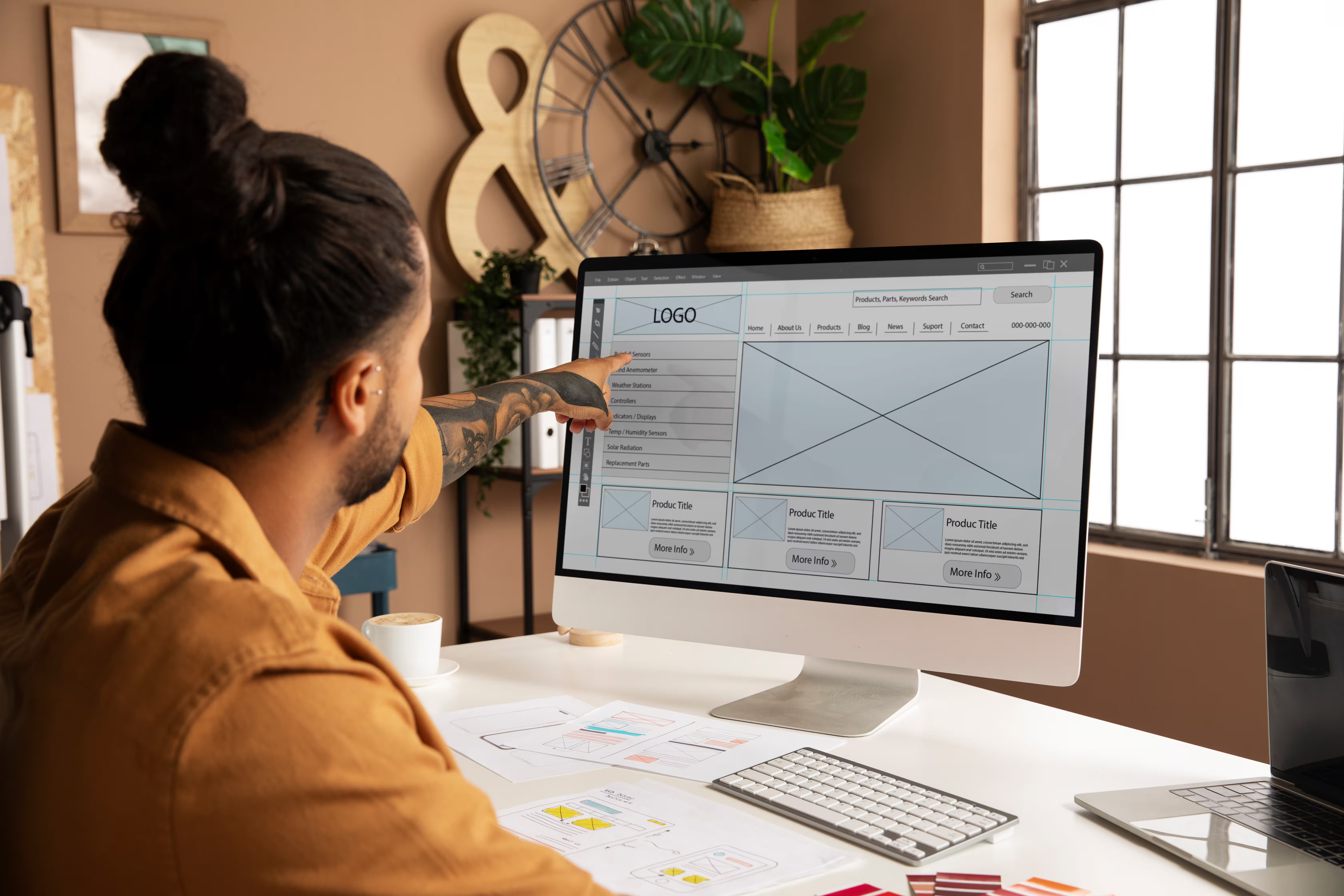Coming to this blog, you are probably looking for the perfect web builder for your next project. Webflow and WordPress are both powerful and popular yet very different. Read further and learn all you need to know before picking the one that fits you.


Webflow vs. Elementor: What’s the difference?
Webflow is a no-code tool that gives you the power to build responsive websites without writing a single line of code. Designers get the power of CSS, HTML, and JavaScript in an easy-to-use visual canvas. With underlying code still accessible, Webflow allows complete design freedom. Webflow goes even further and can handle hosting, security, and website performance itself. It is also more than a website building tool, it's also a CMS and a hosting platform.
Elementor is a WordPress plugin launched in 2015 and is now used on over five million websites. Elementor is a website builder that enables you to build, design, host, and manage a website in a drag-and-drop page builder. This allows everyone to access the front end no matter how tech-savvy it is. Elementor is an advanced templating system with more than 300 available templates for you to choose from.
Ease of use
How hard is it to use Webflow?
Webflow is made with simplicity in mind. Creating custom websites was always a long and rigid process. Designers first had to create a wireframe, and send it to developers. Developers then had to use the wireframe, turn it into code, and send it back to designers.
Webflow founders made their mission to make this process faster and smoother. Webflow enables designers to build and design websites in sync. Designers get the full power of HTML5, CSS3, and JavaScript by using the Webflow Designer.
To start building your site, you can go from scratch, or use an already existing template and customize it. Every element is fully customizable, so we recommend starting with a template. Templates will lay the fundamentals for you and make the web-building process even faster.
To get familiar with Webflow, they even run a free Webflow university. There you can learn all the fundamentals as well as more complex stuff like animation. The videos are not only educational but also really entertaining!
How hard is it to use Elementor?
Elementor is a drag-and-drop editor, allowing you to work only with the front end of your site. It wasn't created only for developers but also for entrepreneurs and marketing specialists. Thus, Elementor is easy to use and doesn't require coding knowledge from you.
WordPress allows you to style content in the backend via the block editor using blocks. Elementor does the opposite and enables you to design your website visually. You see every change you make in real-time. Like Webflow, Elementor offers many pro templates that can boost your workflow. More than 100 available widgets enable you to customize every aspect of your site and make it stand out.
But before you start using Elementor, you must set up WordPress and install the Elementor plugin. Setting up WordPress includes:
- Purchasing a website hosting plant.
- Installing a self-hosted version of WordPress.
- Adding Elementor plugin.
Follow this article to learn how to set it up.
Pricing
Webflow pricing
Webflow offers different pricing tiers divided into three main categories.
- Site plans are best for simple or content-driven websites.
- Ecommerce plans are best for e-commerce stores.
- Workspace plans allow you to manage multiple sites and collaborate with a larger team.
Webflow allows you to first build your whole site for free before deciding to go live. You can tweak your site as long as you want before launching.
Site plans starts at $14/mo and go up to $39/mo for business. Ecommerce plans start at $29/mo and go up to $212/mo when billed yearly for an advanced plan.
When you work in a team, you can pick the Workspace plan. The core plan enables you to invite 3 team members and will cost you $19/mo per seat. The growth plan will unlock up to 9 seats and will cost you $49/mo per seat.
All enterprise plans in every category are completely customizable, and vary case by case. For more pricing details, check out Webflow's pricing page.

Elementor pricing
To use Elementor, you must also consider the cost of hosting a WordPress site. The self-hosted site by WordPress is free to use, but this alone won’t take you far. If you want to use a custom domain or any premium plugins to ramp up your site functionality, this will come with additional costs.
The price of hosting will depend on the hosting provider you choose. This can be anywhere from 0.80$ per month when choosing Hostinger, to 30$ per month when using a hosting provider like Kinsta. The consensus is that the more you pay, the more reliable the hosting will be.
The same goes for plugins. There are a lot of premium plugins you can choose from, yet WordPress became so popular because of all the free plugins. One of the widely adopted free plugins is Elementor. Its core version already gives you more than enough power to build beautiful websites.
If you even need more power and features, you can buy Elementor pro. It will cost you 59$ per year for a one-website license, 99$ for three, $199 for 25 pro websites, and $399 per year for 1000 websites.

Design freedom
Webflow design freedom
Unlimited creativity and design freedom are the main reasons Webflow got widely adopted! It enables you to access the full power of the front-end coding stack without touching code. The tool transforms all your designs into semantic and clean code.
Webflow is not only great for building beautiful and static pages. Albeit a no-code tool, it enables you to bring your website to life with endless animations.
Like most web builders, you can start a project from scratch, or use a pre-made template. What makes Webflow different is that templates are not limiting your creativity. You can edit and tweak every single element to the tiniest detail. Webflow also has a showcase section where you can clone designs from others.
The biggest downside of using Webflow is limiting you to change the designs. Once you set up a website, you can't simply change the design with a single click. You must create a fully new website.
Elementor design freedom
To continue with the biggest Webflow downside, Elementor enables you to change the designs at all times. Even if you have a website with more than 20 pages, you can do this with a simple click.
Elementor is an advanced templating system. The free version gives you offers over 30 templates and the pro version to over 300 pre-made blocks and templates. You can choose among 40 elements in the free version and 90 elements when you upgrade to pro. Those assets give you a large toolbox to design beautiful websites without coding knowledge.
To tweak and modify elements in Elementor, you will work on the control panel on the left side of the page. There you will adjust, change, and control the appearance of your site's elements. When you click on a specific element, the panel will show you the options to modify the content, and adjust colors, effects, and advanced settings.
Content management system (CMS)
Webflow CMS
Adding and modifying elements and new pieces of content all happen in the Webflow Designer. Click on the element you want to edit, and start editing. To further edit page settings, navigate to the page settings area. There you can define titles, slugs, meta descriptions, and other SEO settings. You can even protect your pages with a password. Webflow limits you to a max of 100 pages no matter the site plan.
The good this is that CMS collection items don't count as pages. Collections include content like blog posts, portfolios, authors, etc.
Webflow allows design freedom when building your pages, yet you are very limited when it comes to CMS collection. The settings area to edit CMS items is very user-unfriendly and allows only a few formatting options. Writing more comprehensive content that needs precise formatting is thus hard.

Elementor CMS
WordPress is a CMS with no page restrictions. With all the plugins available, there are endless possibilities types of content you can add. You can manage all your content through the main WordPress menu.
However, the Elementor plugin does not possess its own CMS. Thus, you must create content in WordPress first. Then you can use Elementor to tyle it. Like Webflow, Elementor allows you to modify your content directly in the canvas area. Canvas area will let you:
- Style your fonts and text colors.
- Insert media, columns, and drop caps.
- Add links, headers, and lists.

Search engine optimization (SEO)
Webflow SEO
Webflow has many functionalities to help you grow organically. It runs on clean and semantic code, making your website super fast.
Its latest feature also enables you to convert all images to WebP format, resulting in an even faster site. Google loves high-performing and fast websites. The page speed is an important SEO ranking factor.
Webflow also offers other features that will boost your SEO score. You can add meta descriptions and titles, custom slug, create a responsive design, and a link to your social media. You can also embed social posts on the site and automatically generate sitemaps.

Elementor SEO
Elementor does not have an integrated SEO functionality, but you can always add external SEO plugins. There are many to choose from, and the most popular are Rank Math and Yoast SEO.
Yoast SEO is the most popular WordPress SEO plugin of them all. It allows you to customize metadata and URLs and helps you set up an internal linking structure. Rank Math is more or less the same, yet another SEO plugin for WordPress.

Conclusion
Both Webflow and Elementor are powerful tools when building a website. Whether you are a small business, or a creative professional showcasing a portfolio, both can do the work.
If you are looking for a simple solution to set up your website with 0 coding knowledge, Elementor might be the right choice. Working in WordPress means you also get access to multiple other plugins that can fire up the functionality of your site. If you are a bit more tech-savvy and want complete design freedom with a bit less functionality, Webflow is the way. Using Webflow will help you create a high-performing website with an outstanding design.
We hope we helped you solve the question on how Webflow vs. Elementor stack against each other. If you are still unsure about what platform is the best for you, check how Webflow stacks against Squarespace on this link here.
FAQ
Where does Elementor store data?
Element stores the data in the post meta table in a dedicated directory under 'uploads/elementor/forms/'.
How much does it cost to use Elementor?
How much it costs to use Elementor depends on which version you are using. There is a free version and also Elementor Pro that will cost you from $59 to $399.
Is Webflow easier than Elementor?
Webflow is easier than Elementor since it does not require the process of installing and setting up WordPress.




















